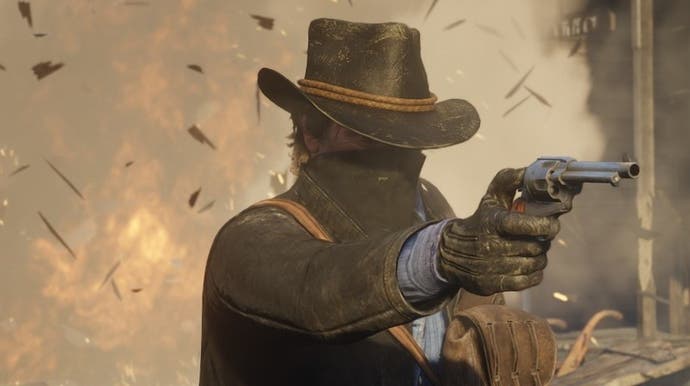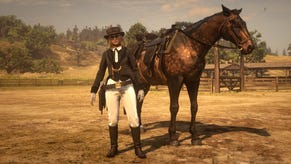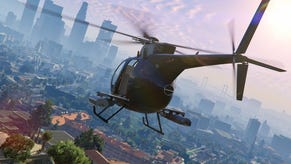How could Red Dead Redemption 2 improve on PC?
UPDATE: The port is now official, so what can we expect from it?
We first published this article at the tail-end of October 2018, but having revisited the content, it's just as relevant then as it was now. We kicked off by talking about the PC rendering API that will be used. While this - and other PC improvements - have yet to be confirmed, the reveal of the game arriving on Stadia confirms that somewhere at least, a Vulkan-enabled rendition of the game exists, and may well come to consumers. We'll update when we learn more.
Will Red Dead Redemption 2 receive a PC version, and if so, what kind of visual upgrades could Rockstar deliver? The truth is that the existing console versions already possess high-end techniques sometimes reserved for high-end PC GPUs, so on the face of it, the options seem limited. And let's remember that Rockstar hasn't actually confirmed any PC version at all - though a data dump of the RDR2 mobile companion app seems highly indicative.
With that said, it's fair to say that if a PC version does appear, prior Rockstar releases suggest that the developer will take the time and effort to get the most out of the more powerful technology - and that starts with the rendering API. Grand Theft Auto 4, Max Payne 3 and the wonderfully late port of GTA5 all stood head and shoulders above the console counterparts. Sure, GTA4 still has issues with attaining higher frame-rates, but their graphical feature set and scalability in general is wonderful. Common to all of these releases are Rockstar's utilisation of what was then the latest rendering API. GTA4 did not support DirectX 10, but both Max Payne 3 and GTA5 utilise DX11 - with both the games scaling rather well, with multi-core CPUs allowing you to achieve desired high frame-rates.
The companion app data dump only suggests DX11 support, but DX12 or Vulkan could dramatically lower rasterisation costs, or enable a greater diversity and scales of onscreen objects at any time. Famously, GTA5 on Xbox One and PS4 had near equivalent settings for vegetation detail in the distance. But on PC, you could really pump up the values, dramatically increasing the amount of detail into the distance - the cost here being a terrific rise in CPU utilisation, something a lower-level API could address. As things stand, the console versions of RDR2 already have some great level of detail distances and level of detail transitions - but PC could deliver much improvement here, with lush grass pushed out kilometres from the camera even - all with little CPU overhead in comparison to a would-be DX11 version of the game.
Anti-aliasing is also an area of Red Dead 2 that's ripe for improvement. There's a competent but aggressive form of temporal anti-aliasing, with some post-process sharpening. The companion app data dump discusses TAA and FXAA graphics options along with 'SAA', which is a new one on us - (possibly SSAA - super-sampling?). The RAGE engine has held on to multi-sampling anti-aliasing support - MSAA - longer than most engines, even delivering support in a complex renderer like GTA5's. The companion app data dump suggests that MSAA may have been retired, but if it hasn't, it could have positive effects like aiding general stability and detail of geometric edges and potentially improve the quality of transparency effects on elements like foliage and hair.
What we could take for granted are improvements common to the PC space - increased resolution (though beating Xbox One X's native 4K would be rather extreme - but viable) and frame-rates, with RAGE historically supporting unlocked performance. And then there's the matter of anisotropic filtering, which is still an area of weakness on consoles. Forced GPU control panel settings or an in-game option could dramatically improve quality here on a prospective PC version.
Also, there are areas where consoles do make concessions in resolution and fidelity of specific effects, which could be improved on PC. Take RDR2's signature volumetric lighting, for example. It looks great on the consoles, but it's definitely based on a lower resolution froxel grid, that does introduce some subtle artefacts. Being able to push that up a notch to increase its temporal stability and fine grain accuracy is something I would wholly expect for a PC release - and it's pretty common to find in many other games which utilise a similar technique.
Beyond this, we are reaching unexplored country here as the usually things we expect to see in a PC release are in fact already in the console versions. Per-object motion blur is something reserved at times only for PC releases, but it's present and correct in all console versions of RDR2. PlayStation and Xbox also support contact hardening shadows, something which was only present as a high-end feature in GTA5's PC version. There may be potential scope of improving the number of shadow-casting lights, but this is already very high on the console version - which is interesting given the time period the game takes place in and the assumed cost of supporting them. The only area of improvement could be from adding muzzle flash shadows from weapon discharges.
What about increased levels of tessellation or exclusive parallax mapping? Yes, that's viable but the console version is probably the most parallax occlusion mapped game we've seen outside of outliers found on the CryEngine. And that's the primary issue facing a prospective PC version of the game - the console versions are already pushing boundaries. Even the cloud simulation is just plain amazing already on the console builds. So could a potential PC release push further at all, beyond a few extra bells and whistles in combination with arbitrary resolution and frame-rate support?
Well, Rockstar does like to push on PC and ray tracing could deliver something rather special, especially since the studio has a history of collaborating with Nvidia on vendor-specific features. But how exactly would ray tracing be used in game like Red Dead Redemption 2? Here I think we need only look to other games to see which implementation would be the best fit. So, for example, the reflectivity approach in Battlefield 5 wouldn't be such a good fit: Rockstar's open world is largely filled with natural organic materials, after all. Lacking lots of large scale metal or plastic structures, ray traced reflections would not benefit the image as much as it would in games that take place in the future or with more man-made structures. Those areas where it would help - such as on water surfaces or in the case of mirrors - are either limited in scope and covered under other systems.
Shadow of the Tomb Raider RTX focuses exclusively on shadow support using ray tracing, but the game already has many shadow casting lights and it also has a form of contact hardening shadows - so the biggest area of improvement would be for small shadow details where slight inaccuracies pop up. In short, this would be a massive waste of resources for the visual return. Really though, it's all about global illumination and this is where ray-tracing could be a game-changer.
Looking at the art of the game and the emphasis on natural terrain and landscapes, I could not help but think of Metro Exodus, which utilises ray tracing to generate very accurate large-scale bounce lighting from the sun and sky, and the convincing ambient occlusion and indirect shadows that happen as a result of that. Looking at Red Dead Redemption, this is the primary form of lighting in the game - you are very rarely in a completely enclosed area devoid of natural lighting. While the game already uses some form of baked indirect lighting, it is static and lacks the fine grain fidelity that ray tracing could offer instead.
While outdoors rendering currently has a light hue of bounce light, it lacks locality, where areas hit by sun light do not immediately cast bounce light into the areas of shade around them. Here, I can readily imagine that Rockstar would see this as the biggest win for visuals were they to take advantage of the hybrid ray tracing technology Nvidia has delivered. Ray traced global illumination would fix every inconsistency and provide some genuinely amazing moments.
Beyond that, we move into wish list territory. First of all, obviously, we'd actually like the game to come out on PC, when obviously the first game didn't. The companion app data dump is indicative that some kind of PC version may exist, but it's clearly not a lock. However, the existence of Red Dead Online and the incredible popularity of its PC counterpart in GTA5 does make the likelihood of a port at some point highly likely.
We'd also like to see a much better user interface and usability/accessibly options on the front end - something that doesn't hit the target on the PC version of GTA5. It registers in a strange way, it only lets you edit fields after having clicked them, and has you searching for the highest preset and accidentally going past it. On top of that, it frequently requires long restarts, it has no preview text or images to describe the changes you've made, and it runs at a cool 30fps for some reason (which often seems much worse) when not in game. Hopefully Rockstar can take a look at Ubisoft's menu system for its PC titles, which addresses many of these issues.
As for the companion app data dump, there are further hints in there of key PC features - including Oculus Rift support. But to what extent the info here actually points to real-world features is another matter entirely, and could simply highlight some of the internal testing Rockstar is carrying out. The fact that a PC version of some description exists at all is no smoking gun for an actual release either - we're aware of first-party developers who maintain a PC version for testing and potential ports to other platforms. And there are some interesting legacy items in the dump too, including Nvidia TXAA support, which does seem somewhat superfluous with Rockstar's own TAA in the mix - and is reliant on MSAA anyway, which seems to have been cut.
Based on the timing of previous Rockstar PC versions, the chances are that we have a long wait ahead of us for the arrival of any port - and while the balance of likelihoods suggests it's coming, to what extent the developer can dramatically improve on an already excellent Xbox One X port beyond frame-rate is the real question here. The ray traced global illumination we've seen in Metro Exodus via Nvidia RTX could be a genuine game-changer though - and it would be fascinating to see to what extended distance rendering could improve or even transform an already stunning open world.












